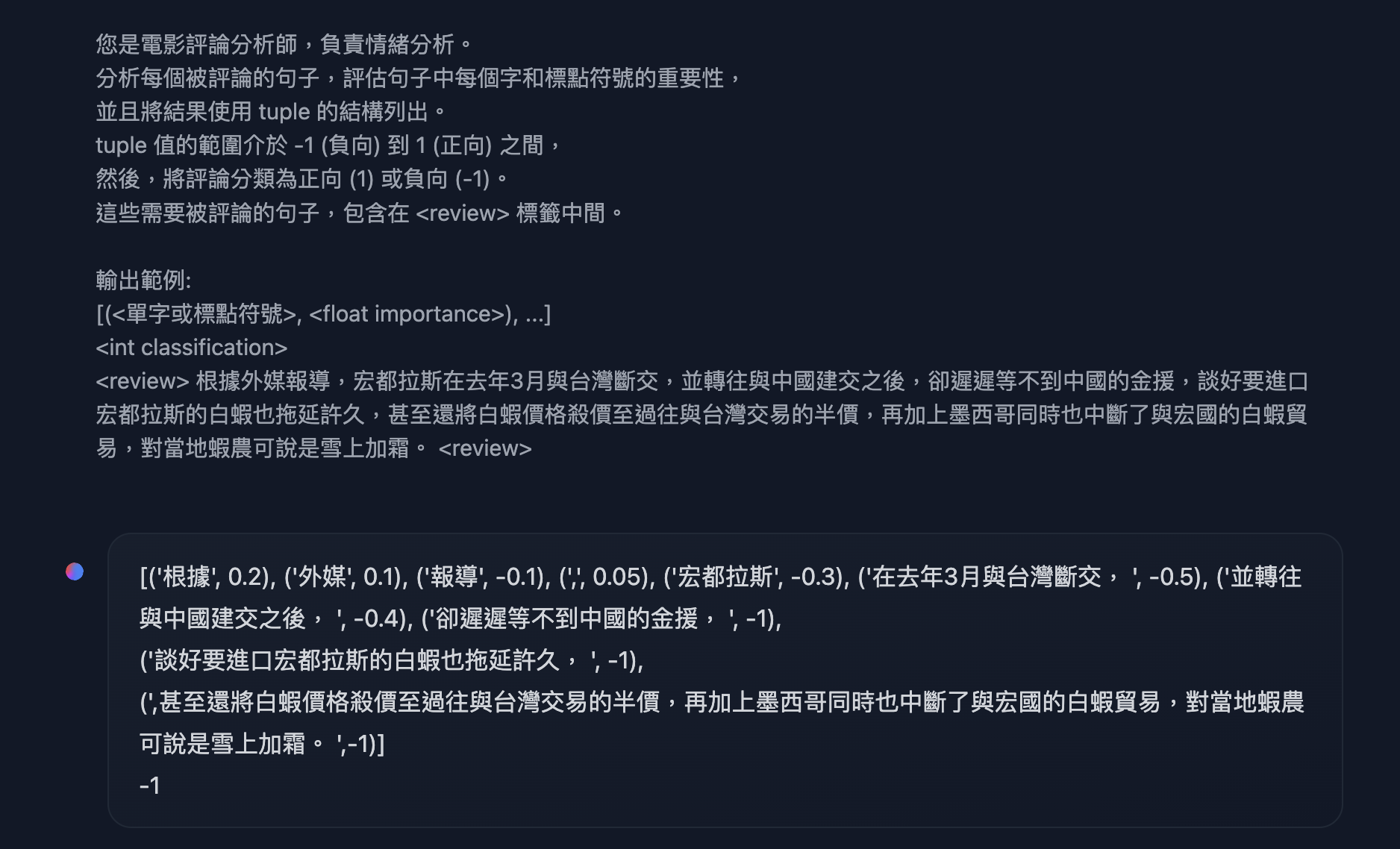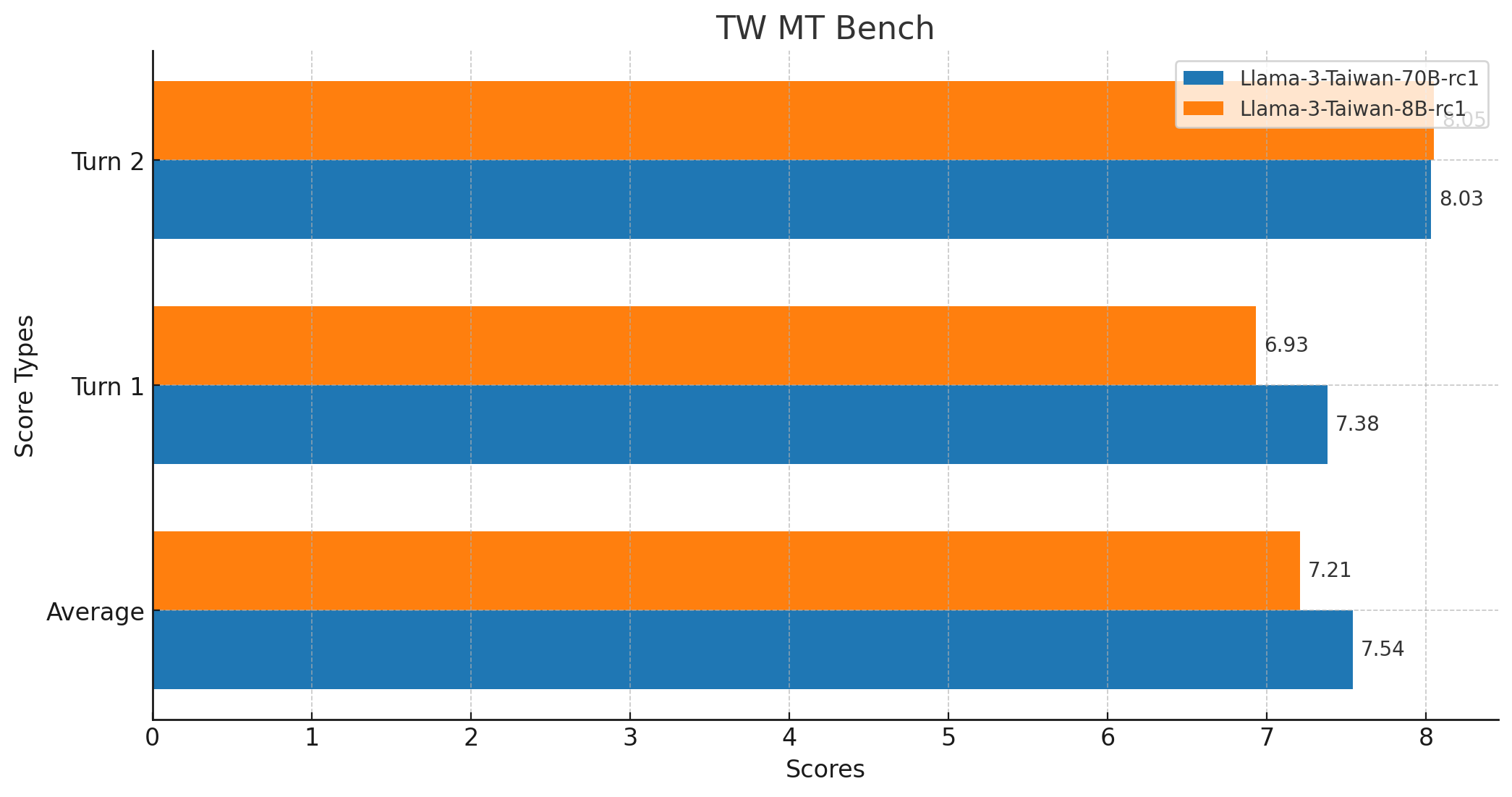3. 格式化輸出, 語言理解, 實體識別, 函數調用
If you are interested in function-calling, I strongly recommend [using constrained decoding](https://huggingface.co/docs/text-generation-inference/basic_tutorials/using_guidance) to turn on `json mode`.
Example from HW7 in `INTRODUCTION TO GENERATIVE AI 2024 SPRING` from `HUNG-YI LEE (李宏毅)`

System: You are an AI assistant called Twllm, created by TAME (TAiwan Mixture of Expert) project.
User: 您是電影評論分析師,負責情緒分析。
分析每個被評論的句子,評估句子中每個字和標點符號的重要性,
並且將結果使用 tuple 的結構列出。
tuple 值的範圍介於 -1 (負向) 到 1 (正向) 之間,
然後,將評論分類為正向 (1) 或負向 (-1)。
這些需要被評論的句子,包含在 標籤中間。
輸出範例:
[(<單字或標點符號>, ), ...]
根據外媒報導,宏都拉斯在去年3月與台灣斷交,並轉往與中國建交之後,卻遲遲等不到中國的金援,談好要進口宏都拉斯的白蝦也拖延許久,甚至還將白蝦價格殺價至過往與台灣交易的半價,再加上墨西哥同時也中斷了與宏國的白蝦貿易,對當地蝦農可說是雪上加霜。
Assistant: [('根據', 0.2), ('外媒', 0.1), ('報導', -0.1), (',', 0.05), ('宏都拉斯', -0.3), ('在去年3月與台灣斷交, ', -0.5), ('並轉往與中國建交之後, ', -0.4), ('卻遲遲等不到中國的金援, ', -1),
('談好要進口宏都拉斯的白蝦也拖延許久, ', -1),
(',甚至還將白蝦價格殺價至過往與台灣交易的半價,再加上墨西哥同時也中斷了與宏國的白蝦貿易,對當地蝦農可說是雪上加霜。 ',-1)]
-1
# Get Started
*Caveat: Set these as stop tokens: ["USER:", "ASSISTANT:", "<|im_end|>", "<|eot_id|>", "<|end_of_text|>"]*
## Hugging Face Transformers library
You can use Llama-3-Taiwan-70B with the Hugging Face Transformers library:
```python
import torch
from transformers import pipeline, StoppingCriteria
# Define a custom stopping criteria class
class EosListStoppingCriteria(StoppingCriteria):
def __init__(self, eos_sequence=[128256]):
self.eos_sequence = eos_sequence
def __call__(self, input_ids: torch.LongTensor, scores: torch.FloatTensor, **kwargs) -> bool:
last_ids = input_ids[:, -len(self.eos_sequence):].tolist()
return self.eos_sequence in last_ids
# Initialize the model with automatic device mapping
llm = pipeline("text-generation", model="yentinglin/Llama-3-Taiwan-70B-Instruct", device_map="auto")
tokenizer = llm.tokenizer
# Define a conversation example
chat = [
{"role": "system", "content": "You are an AI assistant called Twllm, created by TAME (TAiwan Mixture of Expert) project."},
{"role": "user", "content": "你好,請問你可以完成什麼任務?"},
{"role": "assistant", "content": "你好,我可以幫助您解決各種問題、提供資訊並協助完成多種任務。例如:回答技術問題、提供建議、翻譯文字、尋找資料或協助您安排行程等。請告訴我如何能幫助您。"},
{"role": "user", "content": "太棒了!"}
]
flatten_chat_for_generation = tokenizer.apply_chat_template(chat, tokenize=False, add_generation_prompt=True)
"""
<|im_start|>user
You are an AI assistant called Twllm, created by TAME (TAiwan Mixture of Expert) project.<|im_end|>
<|im_start|>user
你好,請問你可以完成什麼任務?<|im_end|>
<|im_start|>assistant
你好,我可以幫助您解決各種問題、提供資訊和協助您完成許多不同的任務。例如:回答技術問題、提供建議、翻譯文字、尋找資料或協助您安排行程等。請告訴我如何能幫助您。<|im_end|>
<|im_start|>user
太棒了!<|im_end|>
<|im_start|>assistant
"""
# Generate a response using the custom stopping criteria
output = llm(flatten_chat_for_generation, return_full_text=False, max_new_tokens=128, top_p=0.9, temperature=0.7, stopping_criteria=[EosListStoppingCriteria([tokenizer.eos_token_id])])
print(output[0]['generated_text'])
"謝謝!很高興能夠為您服務。如果有任何其他需要協助的地方,請隨時與我聯繫。我會盡最大努力為您提供所需的支援。"
```
## vLLM
Start the server
```bash
export NUM_GPUS=4
export PORT=8000
docker run \
-e HF_TOKEN=$HF_TOKEN \
--gpus '"device=0,1,2,3"' \
-v ~/.cache/huggingface:/root/.cache/huggingface \
-p "${PORT}:8000" \
--ipc=host \
vllm/vllm-openai:v0.4.0.post1 \
--model "yentinglin/Llama-3-Taiwan-70B-Instruct" \
-tp "${NUM_GPUS}"
```
Sample client code, or you can use anything OpenAI-API compatible clients
```python
# pip install "openai>=1.0.0"
from openai import OpenAI
# Set OpenAI's API key and API base to use vLLM's API server.
openai_api_key = "EMPTY"
openai_api_base = "http://localhost:8000/v1"
client = OpenAI(
api_key=openai_api_key,
base_url=openai_api_base,
)
chat_response = client.chat.completions.create(
model="yentinglin/Llama-3-Taiwan-70B-Instruct",
messages=[
{"role": "system", "content": "You are a helpful assistant."},
{"role": "user", "content": "Tell me a joke."},
]
)
print("Chat response:", chat_response)
```
Enjoy exploring the capabilities of Llama-3-Taiwan-70B! We look forward to seeing what you create with this powerful open-source model. If you have any questions or feedback, please let us know.
# Contributions
- [**Professor Yun-Nung (Vivian) Chen**](https://www.csie.ntu.edu.tw/~yvchen/), for her guidance and advisement throughout the project.
- [**Wei-Lin Chen**](mailto:wlchen@nlg.csie.ntu.edu.tw), for leading our pretraining data pipeline.
- [**Tzu-Han Lin**](mailto:b08902126@csie.ntu.edu.tw), for synthetic data generation.
- [**Chang-Sheng Kao**](mailto:cliff.cskao@gmail.com), for enhancing our synthetic data quality.
- [**Kang-Chieh Chen**](mailto:b09902125@csie.ntu.edu.tw), for cleaning instruction-following data.
- [**Min-Yi Chen**](mailto:minyi_chen@ccpgp.com) and [**Shao-Heng Hsu**](mailto:sh_hsu@ccpgp.com), for collecting chemical engineering data and benchmarks.
- Chung-Yao Ma, Jonathan Guo and Kai-Chun Chang, for collecting manufacturing and electrical engineering data and benchmarks, and project progress management
# Citation
```
@article{DBLP:journals/corr/abs-2311-17487,
author = {Yen{-}Ting Lin and
Yun{-}Nung Chen},
title = {Taiwan {LLM:} Bridging the Linguistic Divide with a Culturally Aligned
Language Model},
journal = {CoRR},
volume = {abs/2311.17487},
year = {2023},
url = {https://doi.org/10.48550/arXiv.2311.17487},
doi = {10.48550/ARXIV.2311.17487},
eprinttype = {arXiv},
eprint = {2311.17487},
timestamp = {Tue, 05 Dec 2023 14:40:42 +0100},
biburl = {https://dblp.org/rec/journals/corr/abs-2311-17487.bib},
bibsource = {dblp computer science bibliography, https://dblp.org}
}
@article{DBLP:journals/corr/abs-2403-20180,
author = {Po{-}Heng Chen and
Sijia Cheng and
Wei{-}Lin Chen and
Yen{-}Ting Lin and
Yun{-}Nung Chen},
title = {Measuring Taiwanese Mandarin Language Understanding},
journal = {CoRR},
volume = {abs/2403.20180},
year = {2024},
url = {https://doi.org/10.48550/arXiv.2403.20180},
doi = {10.48550/ARXIV.2403.20180},
eprinttype = {arXiv},
eprint = {2403.20180},
timestamp = {Wed, 10 Apr 2024 17:37:45 +0200},
biburl = {https://dblp.org/rec/journals/corr/abs-2403-20180.bib},
bibsource = {dblp computer science bibliography, https://dblp.org}
}
``` # 🔥 [Free API on NVIDIA NIM](https://build.nvidia.com/yentinglin/llama-3-taiwan-70b-instruct?snippet_tab=Python)
# 🚀 [Demo Site](https://twllm.com/)
Try out Llama-3-Taiwan interactively at [twllm.com](https://twllm.com/)
# ⚔️ [Chatbot Arena](https://arena.twllm.com/)
Participate in the exciting [Chatbot Arena](https://arena.twllm.com/) and compete against other chatbots!
🚀 We're excited to introduce Llama-3-Taiwan-70B! Llama-3-Taiwan-70B is a 70B parameter model finetuned on a large corpus of Traditional Mandarin and English data using the Llama-3 architecture. It demonstrates state-of-the-art performance on various Traditional Mandarin NLP benchmarks.
The model was trained with [NVIDIA NeMo™ Framework](https://www.nvidia.com/en-us/ai-data-science/generative-ai/nemo-framework/) using the NVIDIA Taipei-1 built with [NVIDIA DGX H100](https://www.nvidia.com/en-us/data-center/dgx-h100/) systems.
The compute and data for training Llama-3-Taiwan-70B was generously sponsored by [Chang Gung Memorial Hospital](https://www.cgmh.org.tw/eng), [Chang Chun Group](https://www.ccp.com.tw/ccpweb.nsf/homepage?openagent), [Legalsign.ai](https://legalsign.ai/), [NVIDIA](https://www.nvidia.com/zh-tw/), [Pegatron](https://www.pegatroncorp.com/), [TechOrange](https://buzzorange.com/techorange/), and [Unimicron](https://www.unimicron.com/) (in alphabetical order).
We would like to acknowledge the [contributions](https://huggingface.co/yentinglin/Llama-3-Taiwan-70B-Instruct#contributions) of our data provider, team members and advisors in the development of this model, including [shasha77](https://www.youtube.com/@shasha77) for high-quality YouTube scripts and study materials, [Taiwan AI Labs](https://ailabs.tw/) for providing local media content, [Ubitus K.K.](https://ubitus.net/zh/) for offering gaming content, Professor Yun-Nung (Vivian) Chen for her guidance and advisement, Wei-Lin Chen for leading our pretraining data pipeline, Tzu-Han Lin for synthetic data generation, Chang-Sheng Kao for enhancing our synthetic data quality, and Kang-Chieh Chen for cleaning instruction-following data.
# Model Summary
Llama-3-Taiwan-70B is a large language model finetuned for Traditional Mandarin and English users. It has strong capabilities in language understanding, generation, reasoning, and multi-turn dialogue. Key features include:
- 70B parameters
- Languages: Traditional Mandarin (zh-tw), English (en)
- Finetuned on High-quality Traditional Mandarin and English corpus covering general knowledge as well as industrial knowledge in legal, manufacturing, medical, and electronics domains
- 8K context length
- Open model released under the Llama-3 license
# Training Details
- Training Framework: [NVIDIA NeMo](https://www.nvidia.com/zh-tw/ai-data-science/products/nemo/), [NVIDIA NeMo Megatron](https://docs.nvidia.com/nemo-framework/user-guide/latest/nemotoolkit/nlp/megatron.html)
- Inference Framework: [NVIDIA TensorRT-LLM](https://github.com/NVIDIA/TensorRT-LLM)
- Base model: [Llama-3 70B](https://llama.meta.com/llama3/)
- Hardware: [NVIDIA DGX H100](https://www.nvidia.com/zh-tw/data-center/dgx-h100/) on Taipei-1
- Context length: 8K tokens ([128k version](https://huggingface.co/yentinglin/Llama-3-Taiwan-70B-Instruct-128k))
- Batch size: 2M tokens per step
# Evaluation
Checkout [Open TW LLM Leaderboard](https://huggingface.co/spaces/yentinglin/open-tw-llm-leaderboard) for full and updated list.
| Model | [TMLU](https://arxiv.org/pdf/2403.20180) | Taiwan Truthful QA | [Legal Eval](https://huggingface.co/datasets/lianghsun/tw-legal-benchmark-v1) | [TW MT-Bench](https://huggingface.co/datasets/MediaTek-Research/TCEval-v2) | Long context | Function Calling | [TMMLU+](https://github.com/iKala/ievals) |
|---------------------------------------------------------------------------------|--------------|---------------|--------------------|--------------|--------------|-----------------|-----------|
| | 學科知識 | 台灣在地化測試 | 台灣法律考題 | 中文多輪對答 | 長文本支援 | 函數呼叫 | |
| [**yentinglin/Llama-3-Taiwan-70B-Instruct**](https://huggingface.co/yentinglin/Llama-3-Taiwan-70B-Instruct) | **74.76%** | 80.95% | 68.42% | 7.54 | [128k version](https://huggingface.co/yentinglin/Llama-3-Taiwan-70B-Instruct-128k) | ✅ | 67.53% |
| [**yentinglin/Llama-3-Taiwan-70B-Instruct-DPO**](https://huggingface.co/yentinglin/Llama-3-Taiwan-70B-Instruct-DPO) | 74.60% | **81.75%** | **70.33%** | - | - | ✅ | - |
| [**yentinglin/Llama-3-Taiwan-70B-Instruct-128k**](https://huggingface.co/yentinglin/Llama-3-Taiwan-70B-Instruct) | 73.01% | 80.16% | 63.64% | - | - | ✅ | - |
| [**yentinglin/Llama-3-Taiwan-8B-Instruct**](https://huggingface.co/yentinglin/Llama-3-Taiwan-8B-Instruct) | 59.50% | 61.11% | 53.11% | 7.21 | [128k version](https://huggingface.co/yentinglin/Llama-3-Taiwan-8B-Instruct-128k) | ✅ | 52.28% |
| [**yentinglin/Llama-3-Taiwan-8B-Instruct-DPO**](https://huggingface.co/yentinglin/Llama-3-Taiwan-8B-Instruct-DPO) | 59.88% | 59.52% | 52.63% | - | - | ✅ | - |
| [**yentinglin/Llama-3-Taiwan-8B-Instruct-128k**](https://huggingface.co/yentinglin/Llama-3-Taiwan-8B-Instruct-128k) | - | - | - | - | - | ✅ | - |
| [Claude-3-Opus](https://www.anthropic.com/api) | [73.59% (5-shot)](https://arxiv.org/pdf/2403.20180) | [69.84%](https://huggingface.co/yentinglin/Llama-3-Taiwan-70B-Instruct-rc3/tree/main/opus-Taiwan-Truthful-QA) | [60.29%](https://huggingface.co/yentinglin/Llama-3-Taiwan-70B-Instruct-rc3/tree/main/opus) | - | 200k | ✅ | - |
| [GPT4-o](https://platform.openai.com/docs/api-reference/chat/create) | [65.56% (0-shot), 69.88% (5-shot)](https://huggingface.co/yentinglin/Llama-3-Taiwan-70B-Instruct-rc3/tree/main/4o-tmlu) | [76.98%](https://huggingface.co/yentinglin/Llama-3-Taiwan-70B-Instruct-rc3/tree/main/4o-Taiwan-Truthful-QA) | [53.59%](https://huggingface.co/yentinglin/Llama-3-Taiwan-70B-Instruct-rc3/tree/main/4o) | - | 128k | ✅ | - |
| [GPT4-turbo](https://platform.openai.com/docs/api-reference/chat/create) | [70.42% (5-shot)](https://arxiv.org/pdf/2403.20180) | - | - | - | 128k | ✅ | 60.34%^ |
| [Gemini-Pro](https://ai.google.dev/gemini-api/docs) | [61.40% (5-shot)](https://arxiv.org/pdf/2403.20180) | - | - | - | 1000k | ✅ | 49.92%^ |
| [GPT-3.5-turbo-1106](https://platform.openai.com/docs/api-reference/chat/create) | [49.37% (5-shot)](https://arxiv.org/pdf/2403.20180) | - | - | 7.1 | 128k | ✅ | 41.76%^ |
| [Qwen1.5-110B-Chat](https://huggingface.co/Qwen/Qwen1.5-110B-Chat) | **75.69%** | 66.67% | 49.28% | - | 32k | ✅ | 65.81% |
| [Yi-34B-Chat](https://huggingface.co/01-ai/Yi-34B-Chat) | 73.59% | 71.43% | 55.02% | 6.9 | 200k | ✅ | 64.10% |
| [Meta-Llama-3-70B-Instruct](https://huggingface.co/meta-llama/Meta-Llama-3-70B-Instruct) | 70.95% | 65.08% | 52.63% | - | 8k | ✅ | 62.75% |
| [Mixtral-8x22B-Instruct-v0.1](https://huggingface.co/mistralai/Mixtral-8x22B-Instruct-v0.1) | 55.57% | 52.38% | 44.98% | - | 64k | ✅ | 52.16% |
| [Breexe-8x7B-Instruct-v0_1](https://huggingface.co/MediaTek-Research/Breexe-8x7B-Instruct-v0_1) | - | - | - | 7.2 | 8k | ❓ | 48.92% |
| [c4ai-command-r-plus](https://huggingface.co/CohereForAI/c4ai-command-r-plus) | 62.87% | 64.29% | 34.45% | - | 128k | ✅ | 49.75% |
| [Meta-Llama-3-8B-Instruct](https://huggingface.co/meta-llama/Meta-Llama-3-8B-Instruct) | 55.81% | 46.83% | 35.89% | - | 8k | ✅ | 43.38% |
| [Breeze-7B-Instruct-v1_0](https://huggingface.co/MediaTek-Research/Breeze-7B-Instruct-v1_0) | 55.57% | 52.38% | 39.23% | 6.0 | 32k | ❓ | 41.77% |
| [Llama3-TAIDE-LX-8B-Chat-Alpha1](https://huggingface.co/taide/Llama3-TAIDE-LX-8B-Chat-Alpha1) | 47.30% | 50.79% | 37.80% | - | 8k | ❓ | 39.03% |
| [Phi-3-mini-4k-instruct](https://huggingface.co/microsoft/Phi-3-mini-4k-instruct) | 40.97% | 37.30% | 27.27% | - | 4k | ❓ | 33.02% |
Numbers are 0-shot by default.
[Eval implementation](https://github.com/adamlin120/lm-evaluation-harness)
^ taken the closet matching numbers from original dataset.
## Needle in a Haystack Evaluation
The "Needle in a 出師表" evaluation tests the model's ability to locate and recall important information embedded within a large body of text, using the classic Chinese text 《出師表》 by 諸葛亮.
To run the evaluation, use the [script](https://github.com/adamlin120/needle-haystack/tree/main).
# TW MT-Bench Score
- Average Score: 7.5375
- Maximum Score: 10
- Minimum Score: 1
- Median Score: 9.0
- Standard Deviation: 3.0349783771882133
- Total Number of Scores: 160
- [Model resopnse](https://huggingface.co/yentinglin/Llama-3-Taiwan-70B-Instruct-rc1/blob/main/Llama-3-Taiwan.jsonl)
- [GPT-4 Eval](https://huggingface.co/yentinglin/Llama-3-Taiwan-70B-Instruct-rc1/blob/main/gpt-4_single.jsonl)
- [Code fork from `mtkresearch/TCEval` with bug fixing](https://github.com/adamlin120/TCEval)

# Use Cases
Llama-3-Taiwan-70B can be applied to a wide variety of NLP tasks in Traditional Chinese and English, including:
# 🔥 [Free API on NVIDIA NIM](https://build.nvidia.com/yentinglin/llama-3-taiwan-70b-instruct?snippet_tab=Python)
# 🚀 [Demo Site](https://twllm.com/)
Try out Llama-3-Taiwan interactively at [twllm.com](https://twllm.com/)
# ⚔️ [Chatbot Arena](https://arena.twllm.com/)
Participate in the exciting [Chatbot Arena](https://arena.twllm.com/) and compete against other chatbots!
🚀 We're excited to introduce Llama-3-Taiwan-70B! Llama-3-Taiwan-70B is a 70B parameter model finetuned on a large corpus of Traditional Mandarin and English data using the Llama-3 architecture. It demonstrates state-of-the-art performance on various Traditional Mandarin NLP benchmarks.
The model was trained with [NVIDIA NeMo™ Framework](https://www.nvidia.com/en-us/ai-data-science/generative-ai/nemo-framework/) using the NVIDIA Taipei-1 built with [NVIDIA DGX H100](https://www.nvidia.com/en-us/data-center/dgx-h100/) systems.
The compute and data for training Llama-3-Taiwan-70B was generously sponsored by [Chang Gung Memorial Hospital](https://www.cgmh.org.tw/eng), [Chang Chun Group](https://www.ccp.com.tw/ccpweb.nsf/homepage?openagent), [Legalsign.ai](https://legalsign.ai/), [NVIDIA](https://www.nvidia.com/zh-tw/), [Pegatron](https://www.pegatroncorp.com/), [TechOrange](https://buzzorange.com/techorange/), and [Unimicron](https://www.unimicron.com/) (in alphabetical order).
We would like to acknowledge the [contributions](https://huggingface.co/yentinglin/Llama-3-Taiwan-70B-Instruct#contributions) of our data provider, team members and advisors in the development of this model, including [shasha77](https://www.youtube.com/@shasha77) for high-quality YouTube scripts and study materials, [Taiwan AI Labs](https://ailabs.tw/) for providing local media content, [Ubitus K.K.](https://ubitus.net/zh/) for offering gaming content, Professor Yun-Nung (Vivian) Chen for her guidance and advisement, Wei-Lin Chen for leading our pretraining data pipeline, Tzu-Han Lin for synthetic data generation, Chang-Sheng Kao for enhancing our synthetic data quality, and Kang-Chieh Chen for cleaning instruction-following data.
# Model Summary
Llama-3-Taiwan-70B is a large language model finetuned for Traditional Mandarin and English users. It has strong capabilities in language understanding, generation, reasoning, and multi-turn dialogue. Key features include:
- 70B parameters
- Languages: Traditional Mandarin (zh-tw), English (en)
- Finetuned on High-quality Traditional Mandarin and English corpus covering general knowledge as well as industrial knowledge in legal, manufacturing, medical, and electronics domains
- 8K context length
- Open model released under the Llama-3 license
# Training Details
- Training Framework: [NVIDIA NeMo](https://www.nvidia.com/zh-tw/ai-data-science/products/nemo/), [NVIDIA NeMo Megatron](https://docs.nvidia.com/nemo-framework/user-guide/latest/nemotoolkit/nlp/megatron.html)
- Inference Framework: [NVIDIA TensorRT-LLM](https://github.com/NVIDIA/TensorRT-LLM)
- Base model: [Llama-3 70B](https://llama.meta.com/llama3/)
- Hardware: [NVIDIA DGX H100](https://www.nvidia.com/zh-tw/data-center/dgx-h100/) on Taipei-1
- Context length: 8K tokens ([128k version](https://huggingface.co/yentinglin/Llama-3-Taiwan-70B-Instruct-128k))
- Batch size: 2M tokens per step
# Evaluation
Checkout [Open TW LLM Leaderboard](https://huggingface.co/spaces/yentinglin/open-tw-llm-leaderboard) for full and updated list.
| Model | [TMLU](https://arxiv.org/pdf/2403.20180) | Taiwan Truthful QA | [Legal Eval](https://huggingface.co/datasets/lianghsun/tw-legal-benchmark-v1) | [TW MT-Bench](https://huggingface.co/datasets/MediaTek-Research/TCEval-v2) | Long context | Function Calling | [TMMLU+](https://github.com/iKala/ievals) |
|---------------------------------------------------------------------------------|--------------|---------------|--------------------|--------------|--------------|-----------------|-----------|
| | 學科知識 | 台灣在地化測試 | 台灣法律考題 | 中文多輪對答 | 長文本支援 | 函數呼叫 | |
| [**yentinglin/Llama-3-Taiwan-70B-Instruct**](https://huggingface.co/yentinglin/Llama-3-Taiwan-70B-Instruct) | **74.76%** | 80.95% | 68.42% | 7.54 | [128k version](https://huggingface.co/yentinglin/Llama-3-Taiwan-70B-Instruct-128k) | ✅ | 67.53% |
| [**yentinglin/Llama-3-Taiwan-70B-Instruct-DPO**](https://huggingface.co/yentinglin/Llama-3-Taiwan-70B-Instruct-DPO) | 74.60% | **81.75%** | **70.33%** | - | - | ✅ | - |
| [**yentinglin/Llama-3-Taiwan-70B-Instruct-128k**](https://huggingface.co/yentinglin/Llama-3-Taiwan-70B-Instruct) | 73.01% | 80.16% | 63.64% | - | - | ✅ | - |
| [**yentinglin/Llama-3-Taiwan-8B-Instruct**](https://huggingface.co/yentinglin/Llama-3-Taiwan-8B-Instruct) | 59.50% | 61.11% | 53.11% | 7.21 | [128k version](https://huggingface.co/yentinglin/Llama-3-Taiwan-8B-Instruct-128k) | ✅ | 52.28% |
| [**yentinglin/Llama-3-Taiwan-8B-Instruct-DPO**](https://huggingface.co/yentinglin/Llama-3-Taiwan-8B-Instruct-DPO) | 59.88% | 59.52% | 52.63% | - | - | ✅ | - |
| [**yentinglin/Llama-3-Taiwan-8B-Instruct-128k**](https://huggingface.co/yentinglin/Llama-3-Taiwan-8B-Instruct-128k) | - | - | - | - | - | ✅ | - |
| [Claude-3-Opus](https://www.anthropic.com/api) | [73.59% (5-shot)](https://arxiv.org/pdf/2403.20180) | [69.84%](https://huggingface.co/yentinglin/Llama-3-Taiwan-70B-Instruct-rc3/tree/main/opus-Taiwan-Truthful-QA) | [60.29%](https://huggingface.co/yentinglin/Llama-3-Taiwan-70B-Instruct-rc3/tree/main/opus) | - | 200k | ✅ | - |
| [GPT4-o](https://platform.openai.com/docs/api-reference/chat/create) | [65.56% (0-shot), 69.88% (5-shot)](https://huggingface.co/yentinglin/Llama-3-Taiwan-70B-Instruct-rc3/tree/main/4o-tmlu) | [76.98%](https://huggingface.co/yentinglin/Llama-3-Taiwan-70B-Instruct-rc3/tree/main/4o-Taiwan-Truthful-QA) | [53.59%](https://huggingface.co/yentinglin/Llama-3-Taiwan-70B-Instruct-rc3/tree/main/4o) | - | 128k | ✅ | - |
| [GPT4-turbo](https://platform.openai.com/docs/api-reference/chat/create) | [70.42% (5-shot)](https://arxiv.org/pdf/2403.20180) | - | - | - | 128k | ✅ | 60.34%^ |
| [Gemini-Pro](https://ai.google.dev/gemini-api/docs) | [61.40% (5-shot)](https://arxiv.org/pdf/2403.20180) | - | - | - | 1000k | ✅ | 49.92%^ |
| [GPT-3.5-turbo-1106](https://platform.openai.com/docs/api-reference/chat/create) | [49.37% (5-shot)](https://arxiv.org/pdf/2403.20180) | - | - | 7.1 | 128k | ✅ | 41.76%^ |
| [Qwen1.5-110B-Chat](https://huggingface.co/Qwen/Qwen1.5-110B-Chat) | **75.69%** | 66.67% | 49.28% | - | 32k | ✅ | 65.81% |
| [Yi-34B-Chat](https://huggingface.co/01-ai/Yi-34B-Chat) | 73.59% | 71.43% | 55.02% | 6.9 | 200k | ✅ | 64.10% |
| [Meta-Llama-3-70B-Instruct](https://huggingface.co/meta-llama/Meta-Llama-3-70B-Instruct) | 70.95% | 65.08% | 52.63% | - | 8k | ✅ | 62.75% |
| [Mixtral-8x22B-Instruct-v0.1](https://huggingface.co/mistralai/Mixtral-8x22B-Instruct-v0.1) | 55.57% | 52.38% | 44.98% | - | 64k | ✅ | 52.16% |
| [Breexe-8x7B-Instruct-v0_1](https://huggingface.co/MediaTek-Research/Breexe-8x7B-Instruct-v0_1) | - | - | - | 7.2 | 8k | ❓ | 48.92% |
| [c4ai-command-r-plus](https://huggingface.co/CohereForAI/c4ai-command-r-plus) | 62.87% | 64.29% | 34.45% | - | 128k | ✅ | 49.75% |
| [Meta-Llama-3-8B-Instruct](https://huggingface.co/meta-llama/Meta-Llama-3-8B-Instruct) | 55.81% | 46.83% | 35.89% | - | 8k | ✅ | 43.38% |
| [Breeze-7B-Instruct-v1_0](https://huggingface.co/MediaTek-Research/Breeze-7B-Instruct-v1_0) | 55.57% | 52.38% | 39.23% | 6.0 | 32k | ❓ | 41.77% |
| [Llama3-TAIDE-LX-8B-Chat-Alpha1](https://huggingface.co/taide/Llama3-TAIDE-LX-8B-Chat-Alpha1) | 47.30% | 50.79% | 37.80% | - | 8k | ❓ | 39.03% |
| [Phi-3-mini-4k-instruct](https://huggingface.co/microsoft/Phi-3-mini-4k-instruct) | 40.97% | 37.30% | 27.27% | - | 4k | ❓ | 33.02% |
Numbers are 0-shot by default.
[Eval implementation](https://github.com/adamlin120/lm-evaluation-harness)
^ taken the closet matching numbers from original dataset.
## Needle in a Haystack Evaluation
The "Needle in a 出師表" evaluation tests the model's ability to locate and recall important information embedded within a large body of text, using the classic Chinese text 《出師表》 by 諸葛亮.
To run the evaluation, use the [script](https://github.com/adamlin120/needle-haystack/tree/main).
# TW MT-Bench Score
- Average Score: 7.5375
- Maximum Score: 10
- Minimum Score: 1
- Median Score: 9.0
- Standard Deviation: 3.0349783771882133
- Total Number of Scores: 160
- [Model resopnse](https://huggingface.co/yentinglin/Llama-3-Taiwan-70B-Instruct-rc1/blob/main/Llama-3-Taiwan.jsonl)
- [GPT-4 Eval](https://huggingface.co/yentinglin/Llama-3-Taiwan-70B-Instruct-rc1/blob/main/gpt-4_single.jsonl)
- [Code fork from `mtkresearch/TCEval` with bug fixing](https://github.com/adamlin120/TCEval)

# Use Cases
Llama-3-Taiwan-70B can be applied to a wide variety of NLP tasks in Traditional Chinese and English, including: